Creating new pathways for workforce development requires adapting to the shifting needs of a new generation
In the actively changing energy landscape, utilities are grappling with many workforce-related challenges linked to the ongoing shift towards cleaner energy and the modernization of power grids. As veteran employees retire, it is critical to bridge the knowledge and skill gap by recruiting and developing younger talent. While education and technology play crucial roles, adapting workplace behaviors and culture to suit the preferences and expectations of diverse generations is equally vital. Growing a strong, multi-generational workforce has its challenges, but there are many opportunities ahead to ensure today’s utility professionals can support a resilient power system capable of navigating tomorrow’s industry demands.
Related Services
Challenge #1
Knowledge Transfer, Skills Development and Safety Mindset – Building the Next Generation of Power Professionals
Cultivating high-performing professionals at a pace that matches the industry’s demands is one of the most pressing challenges utility companies face today. As technology drives evolution in job roles, organizations must ensure that their workforce is equipped with the necessary skills and expertise to thrive in this fast-paced environment.
As experienced workers continue to retire at an increased rate, organizations face the critical task of transferring knowledge, skills and expertise from one generation to the next. Yet, this process is far from straightforward, requiring systematic approaches and strategic investments to ensure its success. Adequately responding to the rapid pace of change has been challenging for the industry and requires a great deal of foresight and planning to equip the workforce with the necessary skills. Fortunately, there are best practices and examples of successful knowledge transfer and skill development programs that offer organizations confidence to navigate this transition.
Our Take:
By starting with in-depth skills analysis, organizations can accurately determine the skill set of their current workforce and determine the training needed to accommodate the utility’s current and future strategic goals and projects. This effort can create a roadmap to help pass the knowledge to the next generation and prepare them to tackle the most critical grid modernization initiatives that are required of all utilities. By prioritizing the early development of essential skills such as leadership, technical proficiency and safety awareness, organizations can groom their employees to meet the evolving demands of the industry.
Investing time and capital into initiatives such as skill gap analysis, mentorship programs and technology-enabled solutions helps organizations with the seamless transfer of knowledge and expertise across generations. By leveraging the wisdom of experienced workers and the enthusiasm of younger employees, organizations can create a dynamic learning environment that fosters innovation and growth.

Challenge #2
Career Path Flexibility– Navigating Traditional Structures
In a time marked by the rise of the millennial workforce, organizations are facing a generational shift when it comes to career progression approaches. Traditionally, workers began as junior engineers or technicians and worked their way up through a few predictable paths to master, leader, or project manager. Unlike their predecessors, this new generation of employees prefer a more flexible approach focused on skill attainment rather than linear growth paths.
Our Take: To address this challenge, organizations must recalibrate their approach to career development by emphasizing skill acquisition/diversification and providing opportunities for lateral, as opposed to linear, movement. This requires systematic role analysis to identify key skills that are required and a well-thought-out learning architecture to ensure alignment between leaders and employees. Investment in this area will help meet the preferences of a younger workforce while ensuring a steady pipeline of talent ready to take on leadership roles.

Challenge #3
Work-Life Balance Expectations – Bridging the Generational Divide
The shifting expectations surrounding work-life balance present a significant challenge for organizations seeking to foster a harmonious workplace culture and retain top talent. While previous generations may have been willing to prioritize work over personal time, the new generation of employees tends to place a premium on achieving a healthy balance between their professional and personal lives. This preference leads to gaps between generations and impacts recruiting and retention of a critical younger cadre of engineers.
Our Take: Leaders must develop critical skills to facilitate productive conversations with employees regarding personal values and career interests and how they align with organizational requirements. These can be difficult conversations but if done right, they can drive engagement, quality and productivity. Younger generations appreciate employers who are responsive to their needs and concerns. The key is ensuring that prioritize spending time getting to truly establishing lasting relationships with their employees.
Another crucial aspect is eliminating ambiguity in expectations by setting SMART goals. By ensuring goals are Specific, Measurable, Achievable, Relevant and Time-bound, both leaders and employees can have a clear understanding of what needs to be achieved and how success will be measured. This approach shifts the focus from keeping long and strict hours to a focus on meeting deadlines and deliverables, accounting for key metrics versus time.
Challenge #4
Impact of Remote Work Dynamics – Navigating New Frontiers
The rise of remote work presents both opportunities and challenges for organizations seeking to foster a culture of learning and mentorship. While remote work offers flexibility and autonomy, it also poses unique challenges for collaboration, knowledge transfer and training, calling for organizations to adapt their strategies accordingly.
Our Take: To navigate these new frontiers, organizations must invest in technology-enabled solutions that facilitate communication and collaboration among remote teams. By providing platforms for virtual mentorship and knowledge sharing, organizations can ensure that the benefits of mentorship are not lost in the transition to remote work.
For instance, platforms like Zoom, Microsoft Teams and Slack offer features that facilitate virtual mentorship sessions and seamless knowledge exchange among team members. These tools enable remote employees to connect with mentors, share experiences and collaborate on projects regardless of physical location. One way we’ve seen this come to fruition is senior engineers who offer office hours virtually to provide less experienced engineers the opportunity to ask questions, develop their understanding and gain valuable knowledge and insights.
Embracing technology plays a pivotal role in enhancing remote work capabilities. Tools for project management tracking, such as Asana and Trello, and collaborative document editing platforms, like Google Workspace and Microsoft Office 365, empower remote teams to work together effectively and efficiently. Embracing technology not only enables their workforce to thrive, but also keeps organizations competitive and adaptable throughout the digital shift.
Challenge #5
Inspiring the Next Generation – Diversity and Inclusion in Power and Utilities
Inclusion and diversity stand as an ongoing challenge in workforce development. Underrepresented groups lack access to quality education and employment opportunities to set them up for success later in their careers. Traditional recruiting methods based on credentials rather than skills aggravate this issue, hindering diversity initiatives. Key recruiting methods for attracting diverse talent have seen success, only to fall short when it comes to training and mentoring. This turns the challenge into a leaky bucket issue, where strategic recruitment campaigns bring underrepresented talent into an organization, but a lack of representation, mentorship or feeling of inclusion leads to a revolving door effect. Coupled with the challenge of ensuring that the workforce of the future is not only sufficient but also represents diverse backgrounds, this matter only seems to get more complicated.
Our Take: The intertwined challenges of creating a more diverse and inclusive workforce and ensuring a sufficient workforce presents an industry-wide opportunity to inspire through education and motivation. Addressing these challenges requires proactive measures. Organizations must forge partnerships with community organizations and educational institutions to provide equitable access to technical education and employment pathways. Through commitment to these initiatives, organizations set themselves up for future success by creating dedicated future engineers and technicians. Additionally, shifting to skill-based recruitment promotes inclusivity and taps into a diverse talent pool. Investing in leadership development focused on fostering inclusive practices is essential. By prioritizing these strategies, companies can cultivate diverse and inclusive workplaces that drive performance and foster innovation.
TRC embodies this by partnering with local high schools in the communities we serve to educate and recruit the next generation of power and utility workers.


Next Steps
EmPowering the Workforce with TRC’s Power Academy
The challenges facing the utility workforce are diverse and multifaceted, requiring organizations to adopt a proactive and adaptive approach to navigate successfully. By addressing the five key challenges outlined above, organizations can lay the foundation for a resilient and thriving workforce poised to meet the power demands of the future.
As we understand, training is the main battle following recruitment. The training timeline is shorter than ever, making it a top priority to equip the power workforce with the necessary skills and knowledge to tackle the demands of current and future energy projects.
Considering the dire need for workers to get up to speed quickly, TRC’s Power Academy helps empower the utility workforce of today and tomorrow. Our mission is to support organizations and individuals in the power sector to enhance their knowledge and skills through engaging and effective learning solutions. Our curriculum and expert instructors address the current and future demand for qualified workforce challenges and enable skills restoration and advancement of capabilities within the industry. We take a flexible approach to education and leverage varied learning solutions including in-person and virtual instructor-led programs, self-paced online courses, interactive videos and animations, and mentoring systems to ensure tomorrow’s workforce is prepared to face necessary challenges. Learn more about our training center and course offerings or contact us today for more information.



